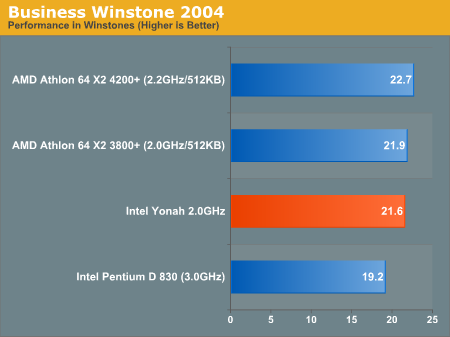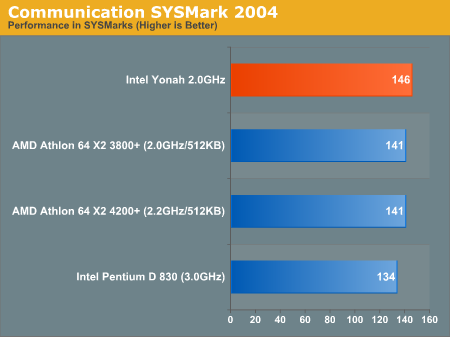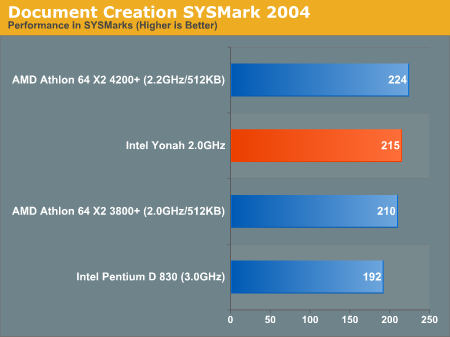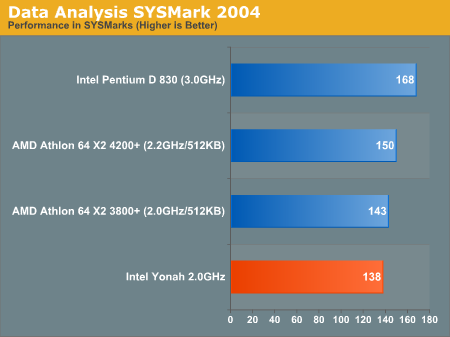Intel Yonah Performance Preview - Part I: The Exclusive First Look at Yonah
by Anand Lal Shimpi on November 30, 2005 2:50 AM EST- Posted in
- CPUs
The Test
Our test configuration is identical to what we used in our Athlon 64 X2 3800+ review, however we can’t disclose the motherboard used for the Yonah platform. We can say that it used the Intel 945G chipset and was outfitted with 2 x 512MB DDR2-533 DIMMs; the rest of the configuration remained the same as the AMD and Intel systems.
Once again, keep in mind that the platform and processor are pre-release samples, and performance could change by the time the parts head to retail. This is nothing more than a preview, so treat it as such.
Business Winstone 2004
Business Winstone 2004 tests the following applications in various usage scenarios:
. Microsoft Access 2002
. Microsoft Excel 2002
. Microsoft FrontPage 2002
. Microsoft Outlook 2002
. Microsoft PowerPoint 2002
. Microsoft Project 2002
. Microsoft Word 2002
. Norton AntiVirus Professional Edition 2003
. WinZip 8.1

Just as we saw in the Dothan vs. Yonah tests, Yonah loses some of its competitive edge in the Business Winstone benchmark. Although in this case, it's not very far off the Athlon 64 X2 3800+.
Office Productivity SYSMark 2004
SYSMark's Office Productivity suite consists of three tests, the first of which is the Communication test. The Communication test consists of the following:
"The user receives an email in Outlook 2002 that contains a collection of documents in a zip file. The user reviews his email and updates his calendar while VirusScan 7.0 scans the system. The corporate web site is viewed in Internet Explorer 6.0. Finally, Internet Explorer is used to look at samples of the web pages and documents created during the scenario."

Yonah manages to be quite competitive in the SYSMark tests, slightly outpacing the Athlon 64 X2 4200+ here.
The next test is Document Creation performance, which shows very little difference in drive performance between the contenders:
"The user edits the document using Word 2002. He transcribes an audio file into a document using Dragon NaturallySpeaking 6. Once the document has all the necessary pieces in place, the user changes it into a portable format for easy and secure distribution using Acrobat 5.0.5. The user creates a marketing presentation in PowerPoint 2002 and adds elements to a slide show template."

Here we see that at 2.0GHz, Intel's Yonah is right in the middle of AMD's Athlon 64 X2 4200+ and the X2 3800+. Given that the CPU has no on-die memory controller, yet performs comparably to an identically clocked Athlon 64 X2, it's not a bad position to be in for Yonah.
The final test in our Office Productivity suite is Data Analysis, which BAPCo describes as:
"The user opens a database using Access 2002 and runs some queries. A collection of documents are archived using WinZip 8.1. The queries' results are imported into a spreadsheet using Excel 2002 and are used to generate graphical charts."

The Data Analysis test is dominated by the Pentium D, but even the Athlon 64 X2 3800+ holds a slight advantage over the 2.0GHz Yonah.










135 Comments
View All Comments
coldpower27 - Wednesday, November 30, 2005 - link
It doesn't seem that bad actually at 423US for 2.0GHZ Yonah at launch, it isn't double the 294US, that they are charging for Dothan 2.0GHZ parts now, the price isn't like the double we are seeing on Athlon 64x2.Furen - Wednesday, November 30, 2005 - link
Huh? I'm saying that the FX-60 will probably match the EE edition of Yonah, which (supposedly) will have a 50+ W TDP and will hardly be a "mid-range" mobile chip.coldpower27 - Wednesday, November 30, 2005 - link
These are the leaked pricing sheets from around the web on the launch pricing of Yonah.T2600/ Yonah 2.17GHZ/667/2MB 637US
T2500/ Yonah 2.00GHZ/667/2MB 423US
T2400/ Yonah 1.83GHZ/667/2MB 294US
T2300/ Yonah 1.67GHZ/667/2MB 241US
T means somewhere in 25W-49W TDP
Yonah Extreme Edition would be interesting, either 2.5GHZ/2.66GHZ if on the same FSB speed.
Furen - Wednesday, November 30, 2005 - link
It would have been nice if you'd included Dothan's power consumption just to see whether or not the "Yonah will have a 49W TDP" claims have any validity. I dont suppose you guys are up to testing the current CPU's current draw directly, huh? :)coldpower27 - Wednesday, November 30, 2005 - link
Also you got to keep in mind Yonah will fall in the T category, of processors which is 25W-49W in TDP, with the way Intel measures it. The acutal TDP of Yonah was supposed to be 31W.Furen - Wednesday, November 30, 2005 - link
Yes, but when Intel announced that Yonah was going to fall into that category EVERYONE (most tech sites, heck, even Cnet) equated that to a higher TDP Yonah, which is why it would have been nice to have something to compare it against.bob661 - Wednesday, November 30, 2005 - link
Anandtech is NOT measuring TDP in these tests!!!!!! They ARE measuring what they call "Total Power Consumption". These are two TOTALLY different measurements. AT can only measure power consumed by the ENTIRE computer coming from the wall socket. They can't measure TDP in these tests. It's not the same. It's not the same. Jesus!Furen - Sunday, December 11, 2005 - link
I never said they could measure TDP. I asked if they were willing to measure the CPU's current draw directly, which is VERY doable, though it takes a bit more effort. If you remember that a month or so ago there were news articles published at, basically, all tech news sites claiming that Yonah would have a greater TDP than it was originally anticipated. Though TDP is not necessarily the typical power draw, a higher TDP (compared to another one that is defined the same way) can lead to a higher current draw.I said that it'd be nice if they could include dothan in order to have a CPU with which to do an apples to apples comparison. Try to keep your patronizing comments to yourself if you don't plan on at least reading what you're commenting on properly.
Calin - Friday, December 2, 2005 - link
Nobody can measure the TDP - TDP is the Total Designed Power - and refer mostly to the cooling capacity of the processor package. You will see several models of processors having the same TDP even if their power consumption is certainly different.The Sempron 2500, 2600, 2700 and I think 2800 have the same TDP - even if the 2500 is a 256kB L2 cache part and the 2600 and 2800 have just 128kB L2 cache.
TDP is NOT power consumption!
Calin - Friday, December 2, 2005 - link
Sorry. TDP is thermal design power